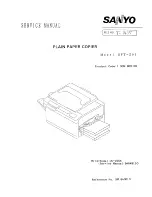
2
2-13
Optional ICC color management for advanced users
Some applications let you assign ColorSync target profiles to RGB images you place in
a document (see the application notes). When you print the document, the application
performs color conversions on the placed images, using the profiles you specified, and
embeds the resulting color data in the document. Three rendering styles are included
in a ColorSync profile, each tailored for a specific type of color output (see page 2-9).
See Chapter 4 for information on setting print option settings that affect printed color.
Color management on Windows computers
The Windows 95 and Windows NT 4.0 operating systems include the Image Color
Matching (ICM) color management system.
• The AdobePS4 printer driver for Windows 95 (included in your DocuColor 40 CP
user software) supports ICM features and all PostScript Level 2 and 3 printing
features.
With Windows 95, you can instruct the Adobe PS4 driver to perform color
management using ICM. To do this, select the “Use image color matching” option
in the Graphics tab of the printer’s Properties dialog box. If the “Use image color
matching” option does not appear, make sure that the printer’s ICM profile is
installed in the Windows\System\Color folder (see Getting Started for instructions).
With the proper ICM settings, the printer driver performs color conversions and
sends the resulting color data to the DocuColor 40 CP.
• The Microsoft PostScript Level 2 Printer Driver for Windows NT 4.0 does not
currently support all ICM features.
• The Windows 3.1x operating systems does not support ICM.
• Some PostScript applications also provide independent color management features
that use ICM profiles (see the application notes).
Source color space profile
A default source color space is defined for every Windows computer monitor. The
RGB Source setting overrides this default source color space (see page 2-8). If you do
not want the monitor’s default source color space to be overridden, set the RGB Source
print option to Off.




































